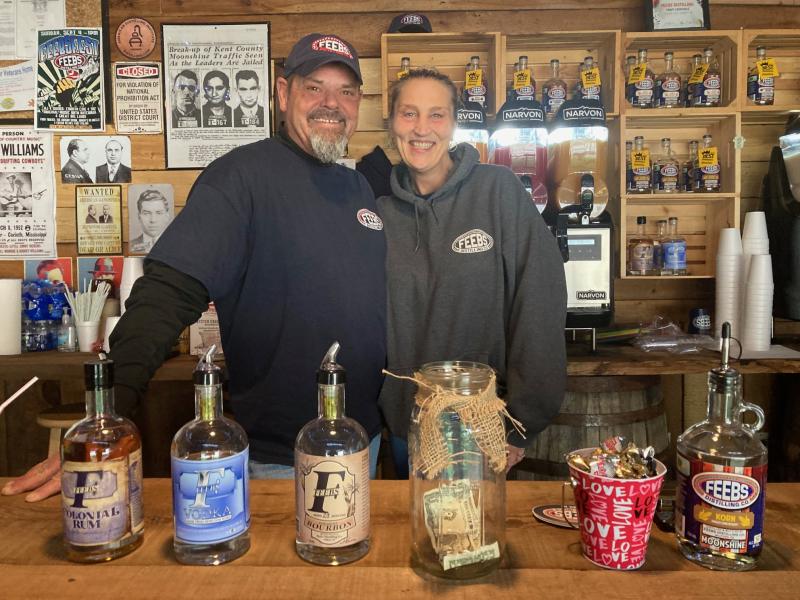For Stacey and Eric Fibelkorn, what started out as a side gig has quickly become a lot more.
Feebs Distilling in Milford has its roots in the Fibelkorn (pronounced Fee-bel-korn) garage, where Eric began building his first still.
“It was basically out of necessity,” he said. “I love good bourbon. Was literally going into the liquor store and spending $200, $300 on bourbon trying to find something. You figure if you’re spending that much money you’d think it would be outstanding, but it wasn’t. I was going to the Harrington library and checking out chemistry books, alchemy, anything I could find that related to making liquor. Studied it for maybe a year. Built my first still. Took probably another year to get some recipes right, and when it got good enough for me to drink, of course I wanted to share it.”
The Fibelkorns decided to open their own business selling Eric’s concoctions. They opened Feebs Distilling in December 2019.
Stacey said, “Now it’s just Eric’s garage on steroids.”
The name Feebs Distilling comes from what Eric said is the longtime family nickname, but it can lead to some confusion for Stacey.
“The first question we get is, ‘Are you Phoebe?’ No, Feebs is easier to say than a mouthful of consonants,” she said.
Much like in the garage, Eric uses stainless steel boilers in his pair of stills, one having a copper column and the other a stainless steel column.
Making bourbon, and to a different extent, vodka, is not unlike making beer. A batch of bourbon starts with hot water and grains mashed together. Which grains are used depends on the spirit. In the case of something like bourbon, Eric said he usually uses malted oats and malted wheat. The grains are then filtered out and the resulting liquid, which contains sugars from the grain that will eventually be turned into alcohol, are then boiled and later cooled. The first main difference between beer and spirits is that during the boil, hops are typically not added to the mix.
The resulting wort is then moved to a fermenter tank where yeast is added to turn the sugars in the wort into alcohol. Unlike beer, which brewers will typically let ferment for around four to eight weeks depending on the style, a distiller like Eric will ferment for two to three weeks on bourbon and three to four weeks for brandy, since there is no dry-hopping or lagering involved in distilling. After fermentation, the spirit will then head to the final step, distillation. The still boils off methanol, evaporates the liquid into steam and runs it through a chiller that converts the vapor back into liquid. Bourbon and rum are both aged in barrels, with a batch of bourbon needing two years before it is ready to drink.
Brandy is more like wine in that it uses fruit that is mashed down and fermented. Yeast is then added and the liquid is run through the still. Rum follows a similar process as bourbon but uses molasses and sugar instead of grains. At Feebs Distilling, Eric makes a colonial rum based on a 17th century recipe.
Much like with beer, water is a key ingredient. Eric said that in places like Kentucky and Tennessee, hubs of American distilling, the water sits on a limestone shelf, the mineral content of which is very conducive to making good liquor. To replicate that, Eric put together a reverse osmosis system in a 250-gallon tank that filters water through limestone he had imported from Tennessee.
The Fibelkorns have seen their pet project pay off, as they have quickly outgrown their 1,764-square-foot facility. Stacey and Eric said the intention is to expand the building to give more room in the brewing area and for storage. The bourbon barrels, in particular, take up a lot of space. Eric said he is also looking to get into brewing his own beer in addition to spirits.
While the future is looking up for Feebs Distilling, the Fibelkorns have not lost sight of the big picture.
“It’s all about making the best liquor I can make,” Eric said.
Feebs Distilling is open Friday from 5 to 9 p.m., Saturday from 1 to 9 p.m. and Sunday from 1 to 6 p.m. For more information, call 302-682-8422.

















































